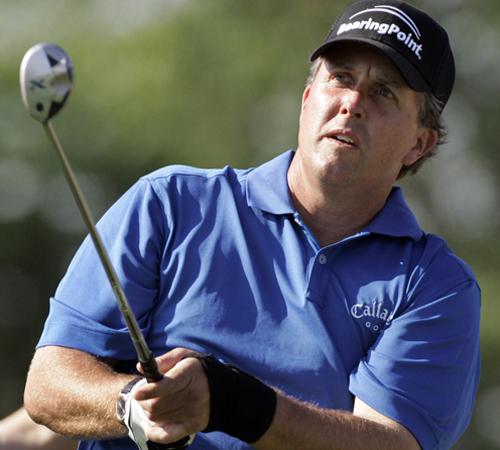Michelson prepares for U.S. Open

Phil Mickelson, wearing an elastic band on his injured left wrist, tees off at the fifth hole during his practice round for the 107th U.S. Open Golf Championship at the Oakmont Country Club in Oakmont, Pa., on Tuesday. The Associated Press
Jun 13, 2007
Last updated on May 12, 2016 at 12:27 p.m.
OAKMONT, Pa. – Phil Mickelson looked more like a bowler than a three-time major champion, adjusting the black brace on his left wrist as he stared down the first fairway, an alley lined not by gutters but the gnarly, ankle-deep rough of Oakmont Country Club.
It was a gentle swing and a favorable result, right down the middle.
He played only nine holes Tuesday, but it was the first time he had played golf since he withdrew May 31 after 11 holes of the Memorial with an inflamed left wrist. He had hoped to play without pain at the U.S. Open, but he will settle for playing.
“I should be able to have it be manageable as long as I don’t aggravate it,” Mickelson said. “Or hit it in the rough.”
Get The Daily Illini in your inbox!
Talk about a miracle cure.
Mickelson’s inability to keep the ball in the short grass is the reason he comes to this major with as much inflammation in his psyche as his left wrist. A year ago at Winged Foot, he was one par away from an elusive U.S. Open title until hitting a tee shot off a corporate tent, against a tree and into a bunker, making double bogey on the 18th hole to finish one shot behind Geoff Ogilvy.
Having already tied the U.S. Open record for most second-place finishes – four – Mickelson showed up at Oakmont two weeks ago for his marathon practice sessions, where he stuck tiny flags on the putting surface and slowly worked his way around the green chipping out of the rough from every conceivable angle. He believes that’s how he injured his wrist.
Now, his best hope this week might be staying out of the thick grass.
“I think it’s important to drive the ball very well here, obviously, and that’s going to be the biggest challenge for me,” he said. “But this should not be a long-term problem if I don’t aggravate the inflammation. And this, unfortunately, isn’t the best week for that, given my driving history.”
It’s not a good week for anyone not at full strength.
Reputed to be the toughest golf course in the country, Oakmont offers a complete test. The course is not the longest, even if it has the longest par 5 (667 yards) and longest par 3 (288 yards) in major championship history. The greens are so fast that the U.S. Open staff actually slows them down to keep it fair.
“It’s probably the most difficult championship that we face all year, because you’re tested from tee-to-gree, and you’re tested on the greens,” two-time champion Tiger Woods said.
“Generally, if you’re missing one facet of your game, more than likely you’re not going to win the championship. You have to have everything going.”
That presumably means all body parts working at full capacity. And while the pain is in Mickelson’s wrist, the key might be his head.
“He’s a power player,” said Ernie Els, another two-time U.S. Open champion who has played with a bad wrist, back and is just now recovering from surgery to repair knee ligaments. “You go at it aggressively, you have to just somehow try and put the pain in the back of your head if you can. I don’t know how severe it is. When you’re under the gun, you get competitive, you want to hit it the way you always do. You’ve just got try to and not think about it.”
This might be the most rust Mickelson has brought to a major championship, certainly this one. He prefers to play the week before a major, but pulled out last week on the PGA Tour to give his wrist more time to heal. Rarer still is not playing a full 18 holes on any of the practice days leading up to the tournament.
“I could have played 18, but I don’t want to push it,” Mickelson said.
He tried to play last Tuesday and couldn’t, so he called his doctors for a cortisone shot to help ease the inflammation. On his way to Pittsburgh, he took a detour to Las Vegas to work with swing coach Butch Harmon. He still couldn’t play.
But with therapy, ice and rest, Mickelson believes it’s getting better.
He switched from bandages to the brace, and says his right wrist also is sore because of favoring it during light workouts. As for his expectation, this is one time Mickelson didn’t want to get into any specifics.
“I want to … continue to improve my ball-striking without aggravating my wrist anymore,” he said.
The best medicine is staying out of the rough – for Mickelson and everyone else.





